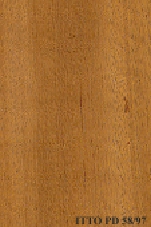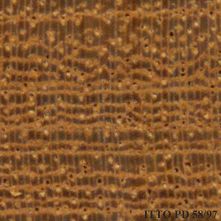
SAPELLI (Entandrophragma cylindricum)
Trade Name
Sapelli
Scientific Name
Entandrophragma cylindricum Sprague
Family
MELIACEAE
Common Names
Aboudikro (Côte d`Ivoire); Sapelli-Mahogani (Germany); M'boyo (Central African Republic); West African cedar; Ubilesan; Tshimaye noir; Scented mahogany; Sapeli; Sapele wood; Sapele mahogany; Penkua; Owuru; Odupon; Miovu; Lotue; Lifuti; Liboyo; Kwabohoro; Gold Coast cedar; Dilolo; Cedar; Bubussu; Botsife; Bibitu; Atore; Acajou sapelle; Aboudikro; Libuyu (Zaire); Sapelli (Cameroon); Sapelli-mahagoni (Germany); Sapele (United Kingdom); Muyovu (Uganda); Undianuno (Congo); Undianuno (Angola); Lifaki (Zaire); M`boyo (Central African Republic); Assie-sapelli (Cameroon); Sapele (Nigeria); Penkwa (Ghana)
Scientific Name Synonyms
Pseudocedrela cylindrica Sprague; Entandrophragma tomentosum A. Chev. ex Hutch. & Dalz.; Entandrophragma lebrunii Staner
Description Of The Tree
Botanical Description
The tree may reach more than 50 m. The bole is straight, cylindrical and straight to 32 m in length. The trunk diameter can attain 200 cm over the broad, low buttresses. Occasionally the buttresses are absent. Log is banned for international trading.(Came
Natural Habitat
Entandrophragma cylindricum occurs in semi-evergreen and evergreen forests. It is reported on rocky ground, in lake-shore forests, deciduous forests, semi-deciduous and almost dry zones and transitional formations.
Natural Distribution
West, Central and East Africa, from Cote d`Ivoire to Uganda.
Wood Identification
Anatomic Description Of Wood
Wood diffuse porous. Occasionally vessels exclusively solitary (over 90%). Tangential diameter of vessel lumina 150 to 200 micras (medium). Brown-colored deposits in heartwood vessels. Non-vestured pits. Vessels per mm2 10 to 20 (abundant). Simple perforation p Axial parenchyma in marginal or in seemingly marginal bands. Paratracheal axial parenchyma scanty and/or vasicentric. Axial parenchyma in discontinuous tangential lines. Occasionally axial parenchyma storied. Prismatic crystals in non-chambered axial parenchy 4 to 10 rays per mm (medium). Occasionally rays storied. Rays 1 to 4 seriate. Body ray cells procumbent with one row of upright and/or square marginal cells (Kribs-III). Septate fibers present. Fibers with simple to minutely bordered pits.
-
 Wood Macro Photo Tangential Plane
Wood Macro Photo Tangential Plane
-
 Wood Micro Photo Of Transversal Section
Wood Micro Photo Of Transversal Section
Availability
Cites Status
Unrestricted
General Wood Description
Odor
Light and pleasant odor.
Color
The sapwood is pinkish grey to whitish, it has a thickness of 7 to 10 cm. The heartwood is red brown to purplish brown, it is clearly demarcated. The silver figure is fine, ripple marks.
COLOR INDEX (1=Black, 7=Light yellow,white)
4
Grain
The grain is slightly but systematically interlocked; special care is needed when drying because of frequent risks of distortion.
Texture
The texture varies from fine to medium.
Luster
The wood is described as low in luster.
Natural Durability
Moderately durable to decay. Without preservative treatment, this species can be used only under risk of occasional re-humidification. It is not suited for uses with risks of permanent or long-lasting humidification. Moderately resistant to termites attack
Natural durability index (1= Very high durability, 7=Vey low durability)
3
Internal Growth Stresses
Residual stresses are reported to be absent.
Silica Content
Silica Content: This timber is reported to have a negligible silica content. Silica contents over 0.05% may affect wood processing. Silica Value: 0
Resistance To Impregnation
Difficult to treat with only a low penetration of the preservative products.
Wood Physical Properties
Basic Density or Specific Gravity (O.D. weight/vol. green) (g/cm³)
0.62
Air-dry Density (Weight and volume at 12%MC) (g/cm³)
0.69
Total shrinkage Tangential (Saturated to 0%MC) (%)
7.2
Total shrinkage Radial (Saturated to 0%MC) (%)
5.0
Drying Defects
Ease of Drying: Terap seasons rapidly to fairly slowly. It takes 1 to 3 months to dry 15 mm thick boards to air-dry condition. Drying Defects: It has a moderate to slight tendency to bow, cup and check.
Recommended Dry Kiln Schedule
FR-9
Dimensional stability ratio (Total Tangential Shrinkage %/Total Radial Shrinkage %)
1.4
Wood Chemical Properties
Wood Mechanical Properties
Bending Strength (MOR),12%MC (kgf/cm²)
1043
Stiffness (MOE) 12%MC (kgf/cm²)
142334
Compression parallel to fiber 12%MC (kgf/cm²)
630
Compression perpendicular to fiber 12%MC (kgf/cm²)
85
Shear strength radial 12%MC (kgf/cm²)
78
Janka hardness (side) 12%MC (kgf)
592
Janka hardness (end grain) 12%MC (kgf)
689
Workability
Sawing
It is easy to saw.
Rotary Veneer Cutting
Suitable for slicing, also suitable for peeling if treated.
Sliced Veneer
Suitable for slicing, also suitable for peeling if treated.
Blunting Effect
Slight blunting effect; ordinary tools can be used for sawing and machining.
Machining
Machining of this species is reportedly easy.
Planing
Moderately easy; tools must be cautiously sharpened.
Moulding
Rather difficult; special tools are needed.
Turning
30
Boring
Rather difficult; special tools are needed.
Mortising
Rather difficult; special tools are needed.
Nailing
Pre-boring is necessary.
Gluing
Difficult to glue because of the extracts content.
Sanding
Difficult to obtain very good results because of interlocked grain.
Polishing
Can be polished without surface preparation.
Steam Bending
Steam bending is difficult.
Response To Hand Tools
No particular problems.
REFERENCED USES
End Uses Summary
HOUSING GENERAL, beams, joists, boards, flooring, parquet, frames, steps, panelling, fittings, FURNITURE AND CABINETS, luxury furniture, cabinets, PLYWOOD AND VENEER, faces, Decorative veneer, TURNING, ornaments, turned furniture, NAVAL CONSTRUCTION, boat deck, port storage
General Housing
- 10 - Silica in Timbers
Beams
- 11 - Prospect: The wood database
Joists
- 12 - Tropical timbers of the world. Part I-Tropical American Species
Boards
- 13 - Dry kiln schedules for commercial woods. Temperate and tropical. Section III. Latin American (Mexico, Central, and South America) Woods–Conventional Temperatures
Flooring
- 14 - Handbook of Hardwoods
Parquet
- 15 - Empire Timbers
Frames
- 16 - Woods of the World
Steps
- 17 - Tree Conservation Database
Paneling
- 18 - W3TROPICOS Missouri Botanical Garden
Fittings
- 19 - Silica in Timbers
Furniture Cabinets
- 21 - Tropical timbers of the world. Part III-Southeast Asian and Oceanian Species.
Furniture, Luxury
- 22 - Dry kiln schedules for commercial woods. Temperate and tropical. Section IV-Asian and Oceanian Woods
Cabinet
- 24 - Empire Timbers
Panels, Veneers
- 25 - Directory of Timber Trade Malaysia
Faces
- 26 - Annual Review and Assessment of the World Timber Situation 1998-ITTO
Decorative veneer
- 28 - Ministry of Agriculture, Fisheries & Forest of Fiji
Turning
- 30 - Embassy of Honduras in Japan
Ornaments
- 31 - Embassy of Colombia in Japan
Turned Articles
- 32 - Embassy of Cote d`Ivoire in Japan
Shipbuilding
- 55 - Tropical Timber Atlas of Latin America
Boat Decking
- 59 - Programa Nacional de uso Sostenible de los Bosques e Incremento a las Exportaciones.
Port Storage
- 62 - Estudio Tecnológico de Maderas del Perú (Zona Pucallpa) Vol I
Please Provide Information To View Producer Information